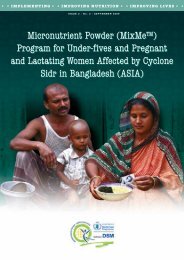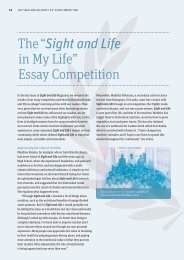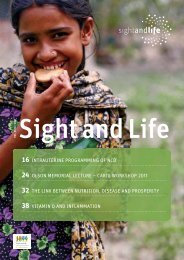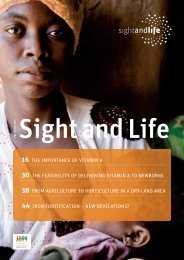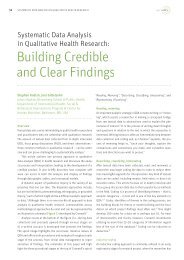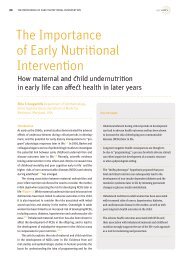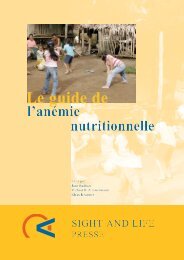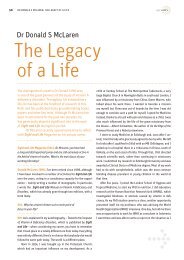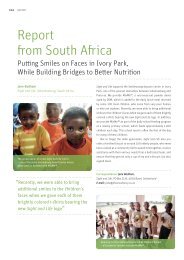Newsletter 02 2006.pdf - Sight and Life
Newsletter 02 2006.pdf - Sight and Life
Newsletter 02 2006.pdf - Sight and Life
Create successful ePaper yourself
Turn your PDF publications into a flip-book with our unique Google optimized e-Paper software.
NEWSLETTER 2/2006<br />
21<br />
SIGHT AND LIFE<br />
Prof. Erdman’s collaborators.<br />
Once the trial studies are assembled<br />
<strong>and</strong> sorted, those that meet<br />
inclusion criteria are rated for<br />
quality in terms of design, inclusion/exclusion<br />
criteria, balance<br />
of population characteristics<br />
across groups, verification of<br />
compliance with the intervention<br />
<strong>and</strong> appropriateness of statistical<br />
analysis. This is done for each<br />
study. The CARIG audience was<br />
particularly intrigued to learn that<br />
any study without a “validated”<br />
dietary intake method would be<br />
excluded from consideration. For<br />
those who know the limitations<br />
of dietary method validation/calibration,<br />
this seems fraught with<br />
arbitrary possibilities.<br />
The pre-final step is to rate the<br />
overall strength of the body of<br />
evidence in terms of type, quality,<br />
quantity <strong>and</strong> studies’ sample size,<br />
consistency <strong>and</strong> replication of<br />
findings, <strong>and</strong> the relevance to the<br />
US general population or target<br />
subgroups. Finally, the claim can<br />
have three degrees of ranking: 1.<br />
conclusive; 2. limited; or 3. very<br />
limited.<br />
The modifications in the FDA<br />
procedures derive from the tension<br />
among consumers’ desire to<br />
preserve health, producers’ <strong>and</strong><br />
retailers’ desire to exercise free<br />
speech, <strong>and</strong> the government’s<br />
duty to protect the citizenry from<br />
consumer fraud. Dr. Ellwood’s<br />
message had shown that the role<br />
of the scientific community lies in<br />
how well they design <strong>and</strong> execute<br />
studies on causal relationships<br />
between a dietary substance <strong>and</strong><br />
a beneficial outcome.<br />
Prof. John Erdman of the University<br />
of Illinois also spoke in the<br />
second session of the program<br />
with a talk entitled: Tomato, Lycopene<br />
<strong>and</strong> the Risk of Prostate<br />
Cancer. He was also awarded<br />
this year’s Wilbur O. Atwater<br />
Memorial Lecture, sponsored by<br />
the United States Department<br />
of Agriculture on 4 April, which<br />
had the theme of carotenes at its<br />
center. His award’s lecture topic<br />
was Colors, Critters, <strong>and</strong> Cancer.<br />
As he explained, the colors refer<br />
to carotenoid pigments; the critters<br />
refer to the selection (limits<br />
<strong>and</strong> possibilities) with different<br />
animal models for investigation<br />
of carotenoid metabolism <strong>and</strong><br />
effects; <strong>and</strong> cancer is specifically<br />
prostate cancer. The context is<br />
the epidemiological evidence that<br />
suggests that tomato consumption<br />
is protective against prostate<br />
cancer.<br />
The world of colorful carotenoids<br />
contains over 650 compounds.<br />
Phytoene <strong>and</strong> phytofluene are<br />
simple colorless precursor carotenoids.<br />
All known members of<br />
this family of compounds are initially<br />
synthesized in plant tissues;<br />
animals cannot form carotenoids.<br />
Prof. Erdman reminded his audiences<br />
that the ripeness of fruits<br />
John Erdman<br />
<strong>and</strong> vegetables is reflected in<br />
their carotenoid content. Carotenes<br />
contribute to the hues<br />
of birds’ feathers <strong>and</strong> insects’<br />
coloring. Moreover, carotenes are<br />
important to aroma compounds<br />
in nature that have importance for<br />
interspecies signaling.<br />
Not all animals h<strong>and</strong>le carotenoids<br />
in a uniform fashion.<br />
It has been found for instance<br />
that, for studies of carotenoid<br />
metabolism related to human<br />
physiology, gerbils, ferrets <strong>and</strong><br />
pre-ruminant calves provide the<br />
best in likeness to human absorptive<br />
systems. They are capable<br />
of absorbing the compounds<br />
both intact <strong>and</strong> metabolized. As<br />
herbivores, rats <strong>and</strong> mice are efficient<br />
converters of provitamin A<br />
carotenoids. They are poor at<br />
absorbing intact carotenoids;<br />
thus, high feed levels are needed<br />
for these rodents to replicate the<br />
tissue concentrations achieved in<br />
humans. In Prof. Erdman’s view,<br />
the armamentarium of animal<br />
models for cancer studies with<br />
carotenoids includes rats, mice,<br />
<strong>and</strong> again ferrets.<br />
The prostate gl<strong>and</strong> <strong>and</strong> carotenoid-containing<br />
foods came<br />
together in the observations of<br />
vastly different spontaneous incidence<br />
rates for prostatic cancer<br />
with 70 times greater incidence<br />
rates in North American blacks<br />
<strong>and</strong> 50-fold increased rates



